Q&A: Cindy Crawford and Matthew Rolston on fame, fashion and what it takes to make an iconic photograph
- Share via
Discovered by Andy Warhol in 1977, prolific photographer Matthew Rolston is known for creating images that visually informed a generation of portrait photographers in the 1980s. The early work of Rolston, who collaborated with Prince, Jodie Foster, Drew Barrymore and others, is currently on full display in a new exhibition, “Hollywood Royale: Out of the School of Los Angeles,” which is open now through April 21 at the Fahey/Klein Gallery on La Brea Avenue in Los Angeles.
This week, The Times caught up with the Beverly Hills-based lensman and his longtime friend and frequent subject, supermodel and entrepreneur Cindy Crawford, who was the co-host of the retrospective’s opening night event on Thursday.
The duo discussed Rolston’s new exhibit, how Los Angeles became a fashion photography mecca, in what way Kim Kardashian West has changed celebrity portraiture, and how the fashion business has shifted now that Crawford’s 16-year-old daughter, Kaia Gerber, is a budding model herself.
How does it feel to be unveiling “Hollywood Royale: Out of the School of Los Angeles”?
Matthew Rolston: It’s really one of those full-circle moments. I’m going to be able to relive some moments from the first decade of my career and see a lot of old friends — which, of course, includes Cindy. [We’ll] celebrate that cultural moment, the rebirth of glamour that happened in the late ’70s and throughout the ’80s, which I got to be part of.
Cindy Crawford: What Matthew said is really true. It really is full circle in so many ways being at David Fahey’s gallery. Besides Matthew, who I started working with probably, like, 30 years ago — which is insane — there are going to be so many other old friends from that time there. I’m super excited to go to support Matthew and the work because it’s such a great recognition of L.A. as a real school of photography. I was fortunate because it happened right when I was emerging as a model. So I was lucky. Before my generation, magazines didn’t fly models to L.A. to work with photographers. They would, maybe, fly the whole team to L.A. to work, but they didn’t really see that L.A. photographers were fashion photographers and, especially, the kind of celebrity photography that Matthew and Herb Ritts and some of the others started doing at around that same time. It was exciting for me to be able to work both in L.A. and New York, and eventually I settled in L.A. So it was convenient that L.A. became a photography fashion capital at that time.

What did it mean to you to be a part of that movement and transition?
Rolston: It was revolutionary. Cindy said it so well. They didn’t believe any photography or any crews had any validity in Los Angeles. Los Angeles was very much looked down on by the New York school, by New York publishing, until the generation I’m part of. I think Herb Ritts and I began working first for Interview magazine with Andy Warhol and later for Rolling Stone. Then I branched off and started to work for Harper’s Bazaar, and Herb started to work for Vogue. We both did a lot of covers. This was completely unprecedented. This had not happened before. I think one of the funny comments that I remember is what Woody Allen said in the script of “Annie Hall” about Los Angeles. This is in the same period. He said, “I don’t want to move to a city where the only cultural advantage is that you can make a right turn on a red light.” It’s very funny. So Cindy is right in saying that this was a moment where the rise of L.A. began culturally for fashion and celebrity and publishing, and we’re living with that today. L.A. has gone through enormous change. We’ve seen it happen. And Cindy and I have been right there.
What does Matthew bring to the table as a photographer?
Crawford: As a model, I think the most important thing is lighting, and Matthew is a master of lighting. [Photographer George] Hurrell had that beautiful, ultra-idealizing-of-the-subject kind of lighting. I feel like Matthew had a modern take on that. [Hurrell] had beautiful lighting — and [it is] also the thing that I appreciate about working with Matthew. Other photographers who also had this — they know. They have a clear vision. It’s not like it just happens on the set. The styling, everything is thought out before, and the work of the day is getting it to come together the way that Matthew sees it in his mind. Sometimes there’s happy accidents, and it’s even better or something wacky happens. But for the most part, I felt like Matthew had a clear vision of what he wanted, to be able to communicate that to your team and know how to get it. And also, it’s storytelling. Fashion photography is storytelling. When everyone is telling the same story, when we all get the vision, it makes for a much more fluid day.
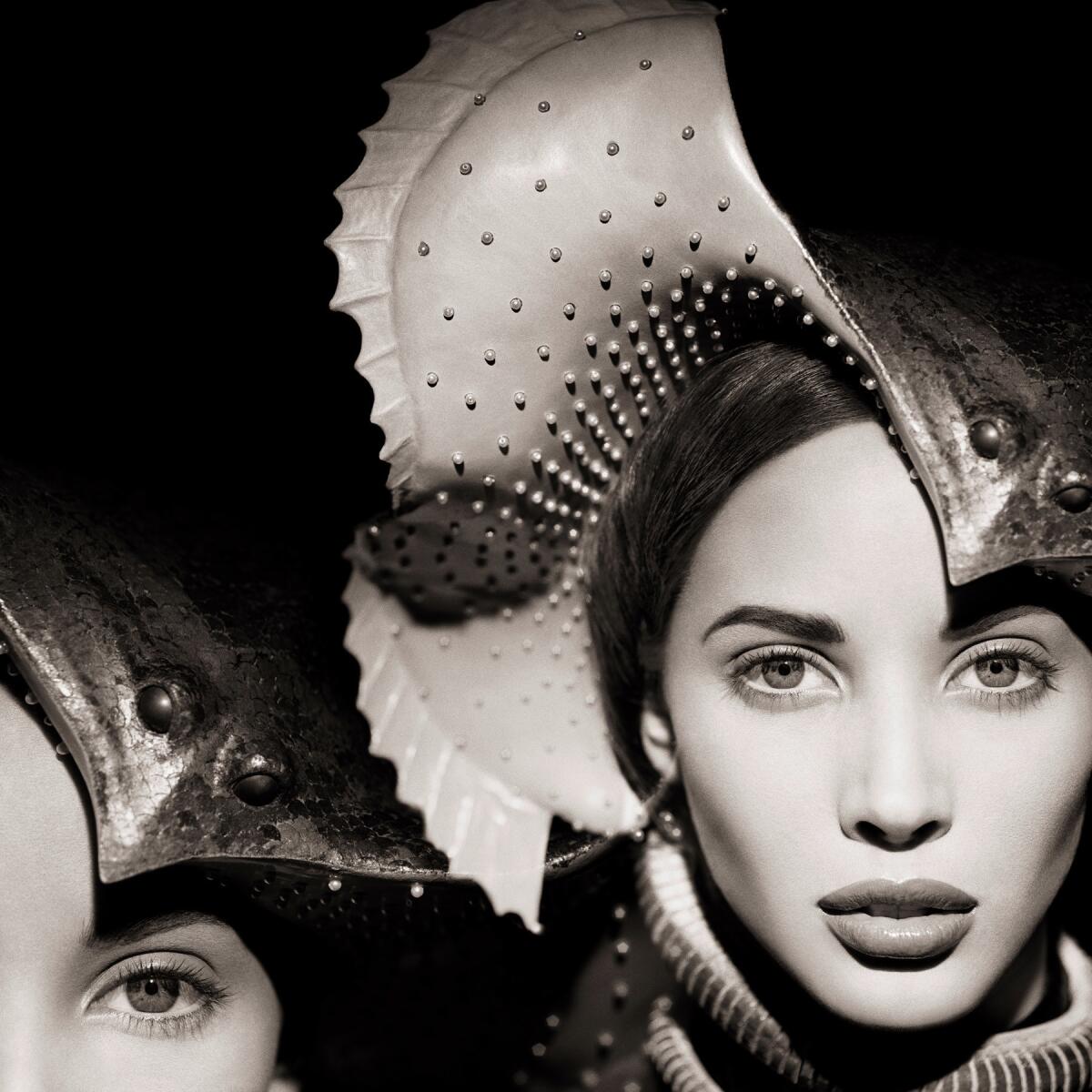
What does Cindy bring to the table as a subject?
Rolston: A lot. Besides, Cindy’s obvious physical gifts, strength, talent, beauty, a tremendous amount of intelligence and thoughtfulness, the ability to transcend the moment, and to communicate visually through a photograph. Her persona is something that you can’t really define, but it’s there. And you know it when you see it, and clearly, Cindy has always possessed that, and she still does richly.
A portrait of Cindy is featured in the exhibit. It’s titled “Paparazzi Portrait.” What makes this image particularly special to you?
Rolston: That picture … What Cindy was saying about preparation and having a concept and telling a story, that story is a comment on Cindy’s fame, on that time. In 1989, when that picture was made, Cindy was at a high point in her career. I think that was the year when she started doing “House of Style” [on MTV]. Is that right?
Crawford: It might not have been the year it started, but it was, like, when people started watching it.
Rolston: There was a peak of interest. Cindy’s had many peaks of interest in her career, but that was one — a very big one. Cindy was probably the most famous model in the world, and I wanted to make a commentary on that visually. My photographs from that time always drew from some element of the past. It was always a visual quotation. And the visual quotation there, which most people wouldn’t get, but, of course, I could tell Cindy — and she understood it perfectly — was a series of pictures done in the ’60s by Richard Avedon for American Vogue of Mike Nichols and Suzy Parker [that mimicked] the style of tabloid paparazzi photography. In Avedon’s time, he was making a comment about Elizabeth Taylor and Richard Burton’s relationship. I wasn’t telling a story of scandal, but I was trying to tell a story about beauty, glamour and fame, which were very much attached to Cindy’s persona — and still are. So that’s why that picture looks like it does. Even though I often employ elaborate lighting schemes, that’s literally a flash on camera. It predates a lot of fashion photography that we’ve seen in the last 10 or 15 years of paparazzi-style, flash-on-camera lighting.

What do you remember about shooting on-set that day? Is there a moment that stands out for either of you?
Rolston: Ladies first!
Crawford: Thank you, but hopefully your memory is better than mine, Matthew, because for me, like so many shoots, unless something unusual happened … I was shooting with Matthew a lot at that time because we would do Revlon together, and we were doing Bazaar. We were together a lot. But for me, what I remember is the actual picture and being in the moment of taking it and understanding what the moment was that I was trying to re-create.
Rolston: Although most people wouldn’t notice these details, but that wasn’t a random choice of location. That was shot in front of the awning of Chasen’s restaurant, which used to be on Beverly [Boulevard]. It was the only one left of the grand Hollywood, glamour restaurants. It’s gone now. That’s where Bristol Farms market is now. So we trekked on down so that I could have that totem of Chasen’s, that green and white awning — it was just so iconic as an emblem of celebrity and fame and Hollywood — in the picture. Another detail about that is that I’m almost 100% positive Peter Savic was the hairdresser that day.
Crawford: I’m sure it was.
Rolston: As always, we’re looking to entertain our audience by shocking. Not shock and awe, but shock and amuse. I think the shock was that Cindy has often been portrayed and is well known for her copious mane of gorgeous brown hair flowing. So this short haircut with short bangs is actually a wig, but it was going to be a surprise for the audience to see Cindy in some way that is different. And, of course, the hairdresser — the minute he sees gorgeous hair — all he can think about is, “Let’s chop it off. Let me make my mark.” So we let him make his mark; not on her actual hair — but with a hairpiece.
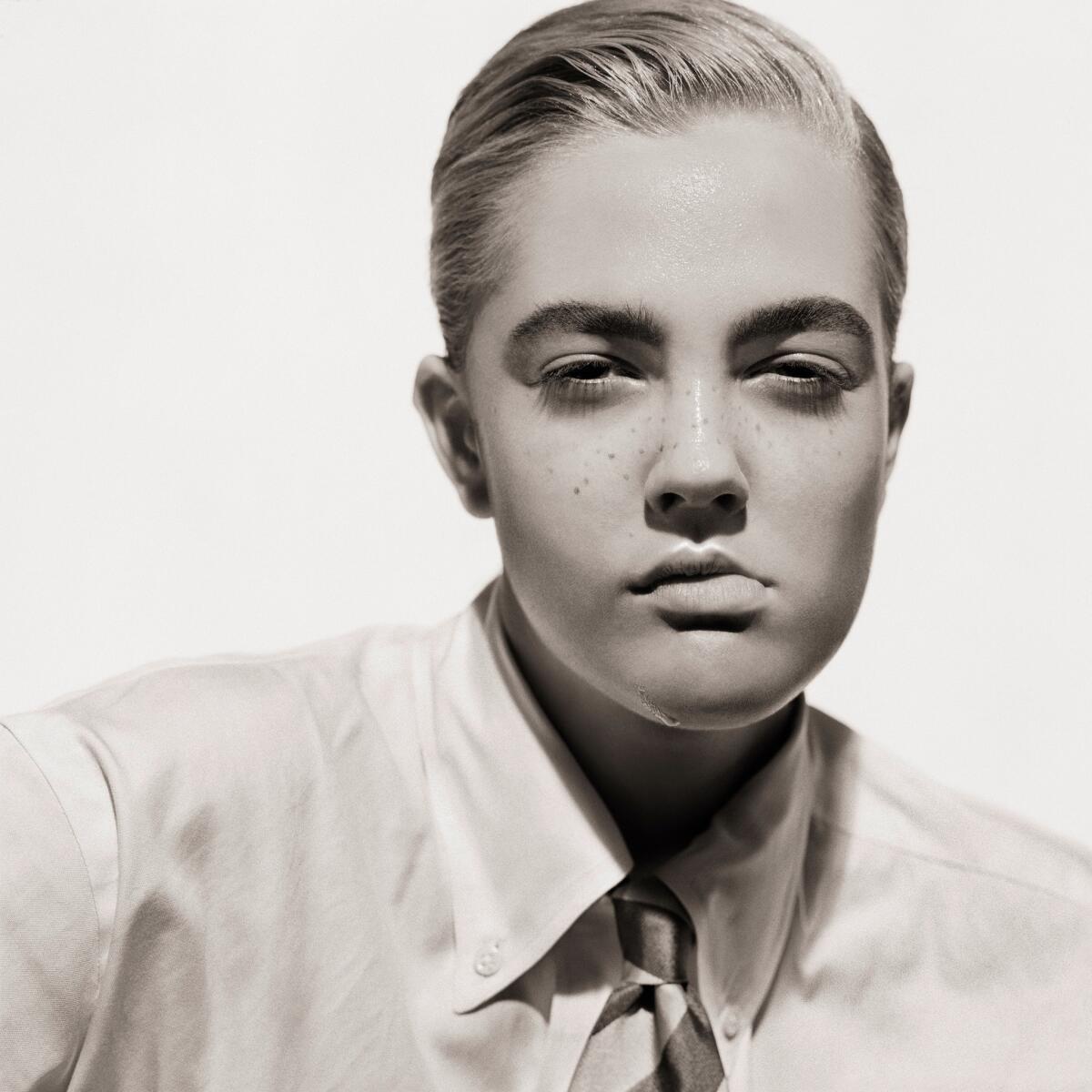
What do you remember about the first time you met?
Crawford: I don’t remember the first time, Matthew. Do you?
Rolston: I don’t. I really don’t.
Crawford: [We’ve worked together] dozens and dozens of times. One of the most memorable experiences that I had — one of the shoots that I loved — was the one that’s also in his book [which is also titled “Hollywood Royale” and is currently available]. With the polo pony. We shot in Florida, right?
Rolston: Yes. We went to Florida to shoot a story based on the glamour of Palm Beach. I think it might have been called “The Palm Beach Story.” It was a ... fashion story for Bazaar.
Crawford: Matthew’s studio lighting is amazing, which is why he did so much cosmetic work for Revlon and different companies, but, to me, that story, that glamorous, idealized version of life is a very Matthew story to me. And to actually be on location, that always helps tell the story. We were totally into the character of it. It was very easy to be the woman — I think I was wearing Armani or something suit-like — walking the polo pony. You become that person the more you’re in the environment. But like I said, Matthew carefully would choose the location. He knew the story, so it was easy for all of us to slip right into it.
Rolston: A funny detail I remember about that shoot, Cindy, is that the crew was Freddie Leiba. He was the editor. The hairdresser was Sally Hershberger. And the makeup artist was Kevyn Aucoin. We were all staying at the ultra-conservative hotel the Breakers. The Breakers was this super stuffy, old school Palm Beach institution. So we’re traipsing through the lobby. Freddy Leiba was an out, gay, black man. Sally Hershberger was an out and gay woman. Kevyn Aucoin was wearing black lipstick and cutoff jeans.
Crawford: He didn’t fit in. You noticed him.
Rolston: Yeah. Because he was 6-foot-4 or something. With his handycam — which predates iPhone. He was shooting everybody and their reactions as we walked through the lobby. An entourage led by the glorious Cindy Crawford. Trailing were a group of people that would really not fit into the stodgy, all-white profile of Palm Beach back then.
Crawford: They made you and I look like wallflowers. [laughs]
Rolston: I think so. And I forgot to add Jewish. So, Jewish, black and gay. That’s our group. It was fantastic.

Let’s backtrack slightly. Matthew, you were discovered by Andy Warhol during your days at Interview. How much do you credit Andy Warhol for where you are today and what did you learn from him during your time working with Interview?
Rolston: It was the first chance for me to be published. My very first published photograph of any significance was a portrait of Steven Spielberg in 1977 that was an Interview magazine while I was still a student at at the [ArtCenter College of Design] in Pasadena. I was actually working when I was a student, which is a long story that I won’t bore you with. But that lit the fire. That led to another assignment, then another and many covers, and then other people recognized me like Jann Wenner [from Rolling Stone] and Harper’s Bazaar and advertising and on and on. That was really a turning point. And what did I learn from Andy? Warhol, at that period, was actually very successful. This is not the Warhol of the Edie Sedgwick, aluminum foil walls, Factory years. His life was surrounded by the most famous, glorious people in the world, and the magazine was the celebration of that. What I learned from Andy was just by watching him. ... When anybody met him or spoke to him, he would compliment you. He would say, “Gee, I love your work” in a very quiet voice. And you believed him because you understood that he knew what you did. And then he said very little. He was really an observer. He was a person who absorbed everything around him and then turned it into art. So I think I had instruction on the art of just being quiet and observing from watching him.
Of the many images featured in the exhibit, which is your favorite and why?
Crawford: Oh, gosh. I don’t think I could answer that. Probably when I go to [the opening] and I see everything [I’ll be reminded]. It’s very different looking in a book, which is beautiful, but it’s a different pace that you look at a book. I’m excited about seeing everything hung on the walls because there’s always one or two that grab you. And it’s usually not the ones of myself.
Rolston: I would say it’s the cover image of the book, which is Prince. Many people ask me why I chose that image. I think that image is so emblematic of the cultural movement of that time. It’s a very simple image. It’s a head on a background, a couple lights. It’s very dramatic. What’s interesting about it is that it questions gender presentation and it questions race. You’re not sure if that’s a black person or a white person because the skin is white and the eyes are blue due to the color manipulation. You’re not sure if it’s a man or a woman. And that is so emblematic of the freedom we were experiencing in the ’80s, before AIDS and the plague took over, and that thread has been picked up today in many ways. So now we have a young generation that feels very comfortable with gender fluidity. In fashion, Gucci is a great example. Boys are wearing the girls’ clothes. Girls are wearing boy clothes. Black and white is mixed together. Younger girls are dressed like old ladies. Old ladies dress like young girls. Just that whole freedom of expression is so caught up in that picture. When you look at Prince’s lyrics during that time, “I don’t know if I’m black or white, boy or girl,” those are all questions in his art. That picture encapsulates that whole era. And I do want to say, just as an aside, that there’s a famous song by Prince called “Cindy C.” from “The Black Album.” It’s a very sexy song. That’s why I say it’s full circle. All these things are intertwined — Cindy and Prince and my career in the ’80s and Andy Warhol and fashion and Harper’s Bazaar and Vogue and the rise of Los Angeles. They’re all intertwined.
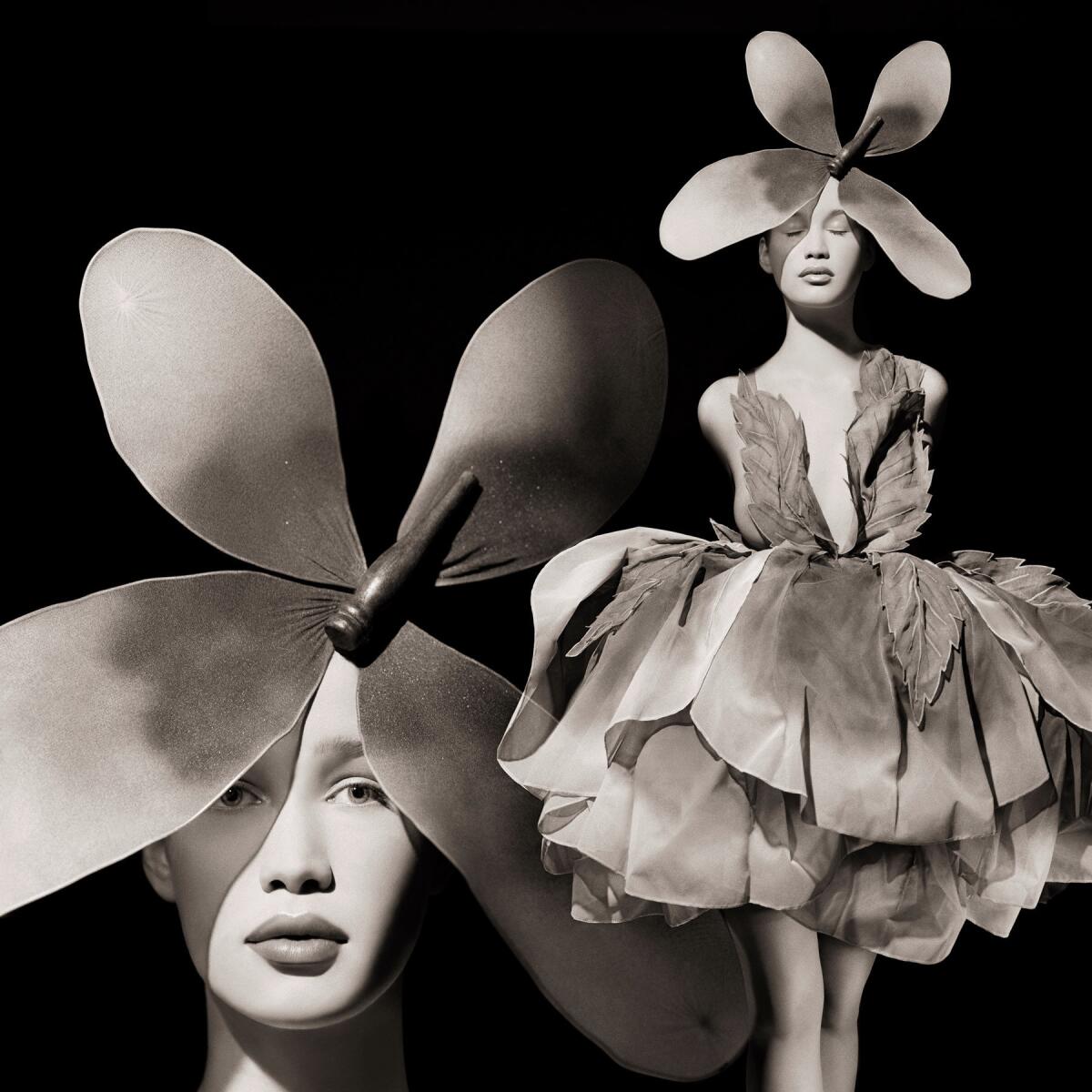
In both of your experiences, how have the modeling and photography industries changed over the years? What’s your take on the industry today?
Crawford: Modeling is not any different. To me, the modeling happens when you get in front of a camera. … Yes, now it’s a digital camera or they’re shooting more behind-the-scenes, but the actual experience of being a model and modeling is the same. But the business is very different and a lot of that is because of social media. There’s a lot more pressure to feed that machine as well as just do your job as a model. I see it through, you know, I have a 16-year-old daughter who is emerging into the scene as a young model, and she’s doing shows right now in Paris. It’s the same. It’s literally exactly the same. With the addition of social media, which, in some ways, I think it ramps up. It’s like you go from 0 to 60 much faster. Because there’s daily exposure to you, to your fans; where back in the day if I had fans and I was on the cover of Vogue one month, they had to wait another month to see, “Oh, is she going to be in Vogue or is she going to be in Bazaar? Where is she?” But now it’s daily exposure, which, in some ways, is a good thing because if you’re on a trajectory of a rising star, it happens very fast, but I think it also makes it possibly [difficult] … . We’ll see if the shelf life is shorter because of that. Because everyone’s always [looking for what’s] new, more, what’s next, and I feel like the use-up rate is faster now, possibly. That would be my comment. Matthew, what do you want to say?
Rolston: I don’t really come from the fashion world, to be honest. I come from the celebrity world. Even the fashion series that I did for Harper’s Bazaar [and other] magazines, always involved either an extremely famous model like Cindy, who was a personality in her own right or an actual celebrity modeling clothing. That was the beginning of the celebrity takeover of magazine covers, and I was a part of that movement. You rarely, since that time, have seen models unless they’re very, very well known models on the cover of any magazine. So I’ll comment more from the standpoint of celebrity photography, which has undergone a tremendous change. I would say that photographers of my generation or my type interpreting celebrity through our photography is possibly over. Really, it feels very outdated to me. When Kim Kardashian is in the third printing of her book at Rizzoli called [“Selfish,”] we have to recognize that that’s a significant development. Twenty-five or 30 years ago, there might have been a third printing of a book of portraits by a great photographer like Richard Avedon, but now they’re in the third printing of [“Selfish”] by Kim Kardashian. I think that the interpretation of celebrity has fallen to the celebrities themselves. They have taken it over and they control their image. They make the images of themselves. It hasn’t quite happened in fashion yet. We haven’t yet had a model do a selfie story. Although it must have happened, but it hasn’t taken over fashion. But in celebrity, to feed that machine that Cindy is talking about, which isn’t really even daily, it’s minute by minute or hourly, these people are employing some of the same photographic techniques. There is not a single picture of Kim Kardashian or most celebrities that goes out that isn’t retouched immediately before it gets tweeted out or put on Instagram. So the idealization of glamour goes on. It’s just in other people’s hands than the photographer.
Crawford: I would say that I also think, because of social media, that what the audiences are looking for is [different]. They want to see the more not-perfect retouched [look]. Even though, as Matthew said, a lot of people do retouch their own selfies or whatever, but people want to feel like they’re getting the real person, not these idealized images.
Rolston: That’s so true. The “making of” is more important than the “of.”
Crawford: I always say the photo shoots now are an excuse for a behind-the-scene. [laughs]
Rolston: That’s very true.
Crawford: But I prefer and still like the finished images. I’m old school.
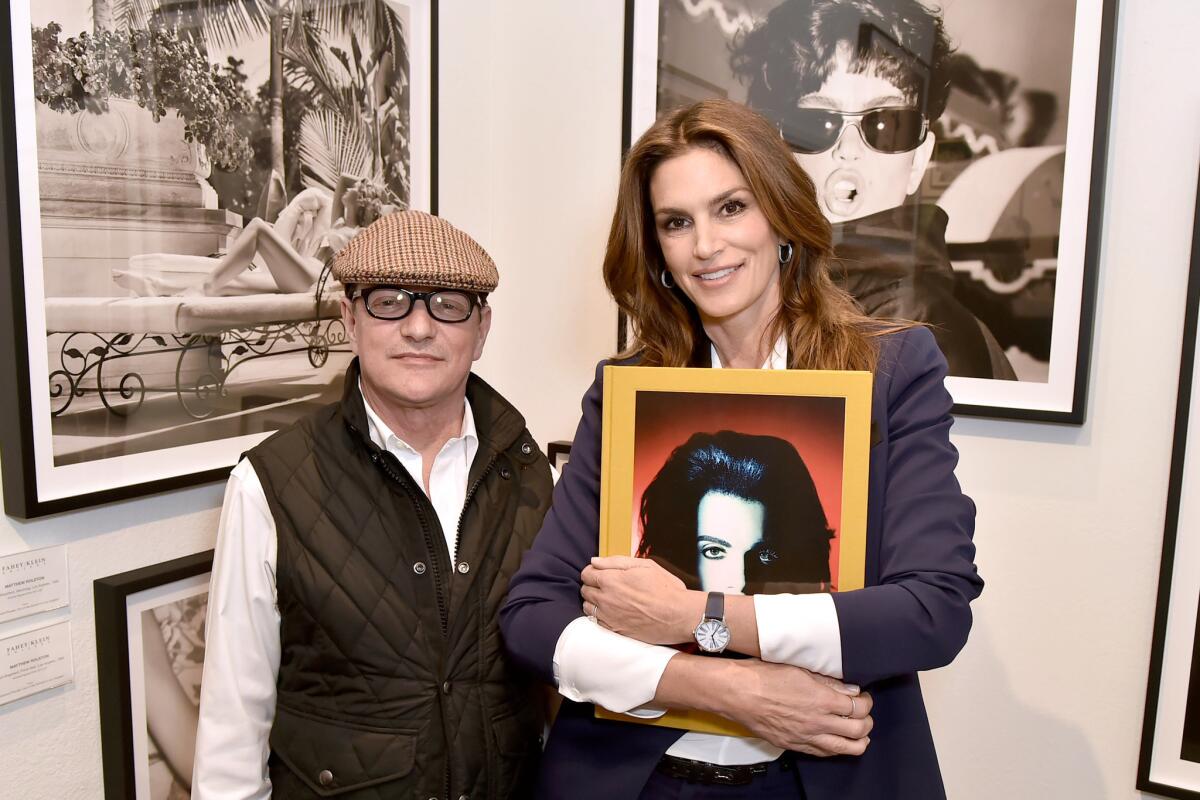
Matthew, who would you love to shoot that you haven’t yet?
Rolston: There are so many [people]. People always say, “You’ve shot everybody.” Hardly. I mean, Tilda Swinton comes to mind. I’ve never worked with her, and I’m a huge fan. That’s my idea of modern glamour.
Crawford: Helmut Newton used to say he either had to love his subjects or hate his subject. He couldn’t be ambivalent. He would be into shooting someone if he really didn’t like them but he had to have some kind of strong emotion — good or bad — which I thought I was interesting. I was, like, “Well, I hope you love me.” I think he did based on the way he shot me.
Rolston: I’m glad you brought up Helmut Newton’s name because he is really an important part of the story of the glamour revival. I’m not responsible for the glamour revival. I’m a result of it. The people who are really, in my mind, responsible for reviving glamour and putting it back in play are two people — Helmut Newton and Andy Warhol. And both of them gravitated to George Hurrell, who was the original greatest Hollywood photographer who was still alive in the late ’70s, and it was those interactions that I saw that influenced me, Herb Ritts, and many others.

Matthew, you also have a second exhibit on display through March at the Ralph Pucci showroom. It’s titled "Art People: The Pageant Portraits." What can you tell me about that?
Rolston: As it relates to this, to “Hollywood Royale,” it’s an interesting position. It happened accidentally, but “Hollywood Royale” is the first 10 years of my career and it includes my very first important published photograph in 1977. So that’s as O.G. as it can get for me. The show at Ralph Pucci called “Art People” is a fine-art project. It is so recent that I was still printing and framing them the week before this show went up. So I’m in the unique position in my hometown, at the same time, of having two shows up — very different ones. My earliest work and my literally most recent work. At the same time, on opposite sides of Hollywood. That’s a personal best for me to [have it] happen accidentally.
Beyond these exhibits, what are you working on next? What do you like to shoot these days?
Rolston: I am not that active in magazine work anymore. I do advertising from time to time. And as far as photography, I’m creating fine art and I’m onto my fourth project right now. That’s the one I’m working on now. The third one is the one for Ralph Pucci. Professionally, I’m working as a creative director in the hospitality area. My clients right now are in hospitality — meaning hoteliers and restaurant owners and big hotel corporations. I’m about to have my sixth hotel project open at the end of this year in San Francisco, which I did for Richard Branson for Virgin Hotels.
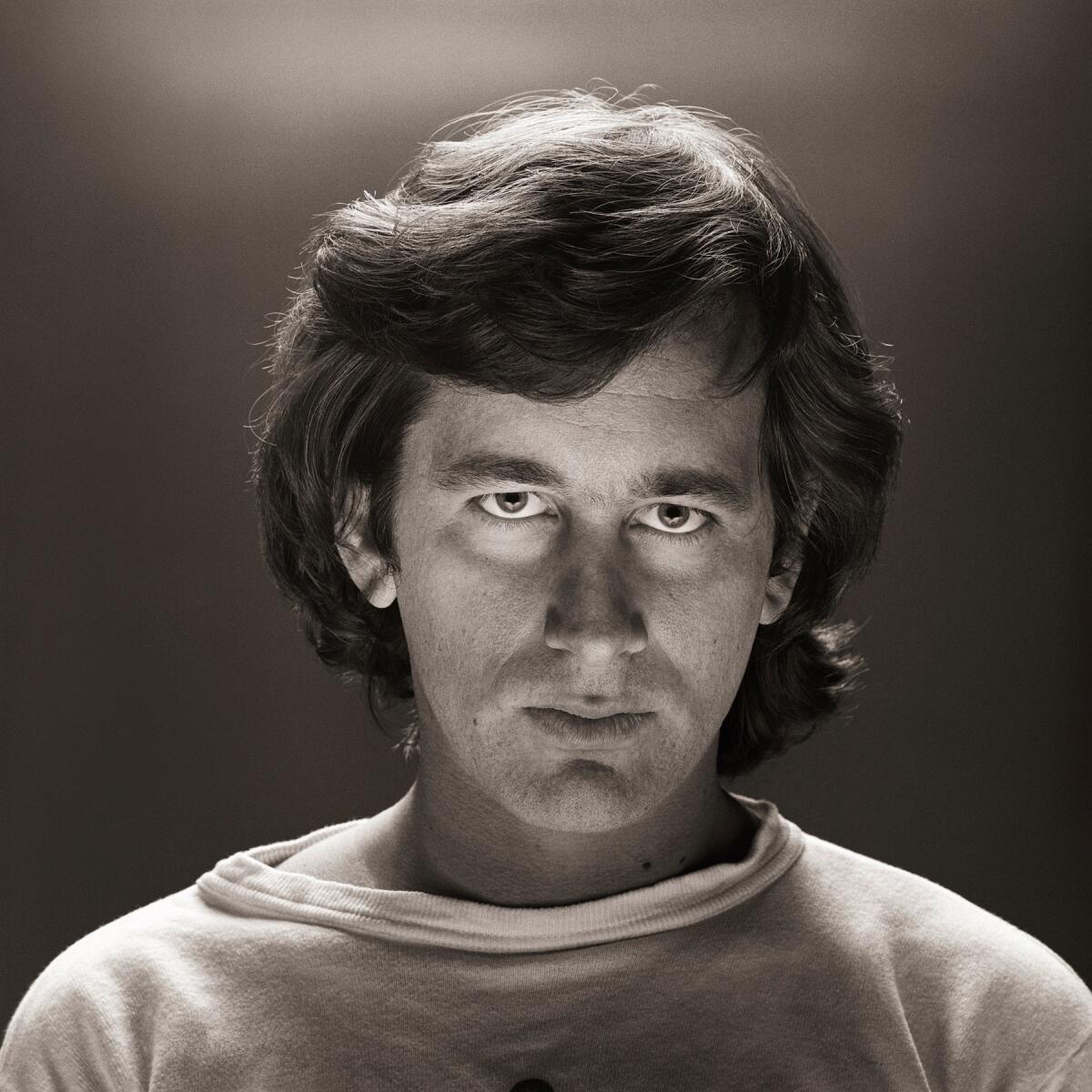
Cindy, what are you working on that you’re personally passionate about?
Crawford: I’ve had a skin-care line called Meaningful Beauty that I launched over 10 years ago. Probably 50% of my work energy goes toward that. And then I’m still [with] Omega watches [which I’ve done] for 25 years, which is probably the longest contract in the history of celebrity relationships and ambassadorships. And I have a furniture line that I do. I like being busy. And then the new stuff is really helping my kids navigate this world. Because of that, I’ve re-entered into fashion in a way. In September, I went to fashion week to accompany my kids. It’s back to that full circle thing. It’s reconnecting with [people] like seeing Karl Lagerfeld at the Chanel show and then sitting in the front row watching my daughter. It’s kind of surreal, but it’s been fun to reconnect with a lot of people. Because when I moved to L.A. and we moved to Malibu — so we’re really kind of isolated — I wasn’t fully [immersed] in the fashion scene. Once I had kids and we moved out here, I’d go to Met Ball once in a while or something, but in the last year, I’ve been in it a lot more through my children. Because of that, I’ve ended up doing some things that I probably [wouldn’t have otherwise]. I just shot for POP magazine and have been doing some fun things just because I think I’m back in people’s minds again a little bit because I’ve been out there a little bit more. I still have fun. Modeling is really a skill. Just because you’re [older] — you know, I’m 52 now — doesn’t mean that I’m still not good at it. I certainly look differently than I used to, but I still love — especially when you have a great rapport with the photographer — getting in front of that camera and creating these [images]. To me, it’s about storytelling, so it’s, like, “How do we tell this story and what is my role?” The one thing I do like about digital is that usually now there’s a monitor, so I can look at the monitor whereas before we had to wait for Polaroids or whatever. So I can look at that and go, “Oh wait. How can I help this picture?” You get feedback more quickly. When the right project comes up, I’m still happy to [do it]. I like working with young photographers. And Matthew and I did a project together last year for Umami Burger because they do a charity [project] where a celebrity designs a burger and the money goes to charity, and that was the last time Matthew and I got to work together. I’m still open to things that sound interesting and fun, but my core is my skincare and Omega and my furniture line. And my family, of course.
For fashion news, follow us at @latimesimage on Twitter.
The biggest entertainment stories
Get our big stories about Hollywood, film, television, music, arts, culture and more right in your inbox as soon as they publish.
You may occasionally receive promotional content from the Los Angeles Times.







